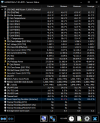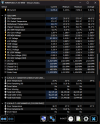Thank you Zach, for the detailed descriptions of what each reading does. That helped more than even the pop-up window in the program itself and each one is very close during a stress test.
This build is actually a CyberPowerPC that I got at close out a couple years ago...paid less for the entire system than what it would've cost me to buy a 5700 and 3700X alone so I could not pass it up. I know a lot of people have nothing but bad things to say about them, but I've owned two and never had an issue until now. I may be making my "issue" bigger than it needs to be, though.
With that said, neither ASRock nor Cyberpower officially have the BM550AM Gaming motherboard or a BIOS listed on their websites. I did find this directory after searching other forums, but the fact it's not a secured site and 2 of the 3 file labels are not the proper name, I'm a bit skeptical (
http://www.cyberpowerinc.com/drivers/?dir=Motherboards/MB-478-101 B550AM GAMING/BIOS).
I switched the Windows Power Option to Ryzen Balanced. It was on Windows High Performance, which is what I thought I had it set at previously, but now I'm not so sure. If it got changed, it was the recent Windows Update. The idle temps seem to be better with far fewer spikes, but the temps still rise quickly on both CPU-Z and Cinebench. The temps while using the browser is now in the low-mid 40s with a few spikes to upper 50s.
I just tested it out in a few games with Control and Cyberpunk being the two that got the hottest after 20minutes. Even then, Control recorded an average of 69.1C and Cyberpunk an average of 72.0C. Both games were at 1440p with the highest settings and all ray tracing effects turned on. The max temp recorded during both games was 79C and that was just on a quick spike here and there according to the graph. The temps seemed to stay pretty steady during both games and there was no obvious climb...they pretty much stopped at what the average temp was reported as.
Dalai, I checked the cooler again and even tried to tighten the screws but they were already tight. Considering the extra heat in the case from the GPU (max temp 68C), and the extra processing power used for the extra effects such as ray tracing, these temps are not too far off from what I had before.






